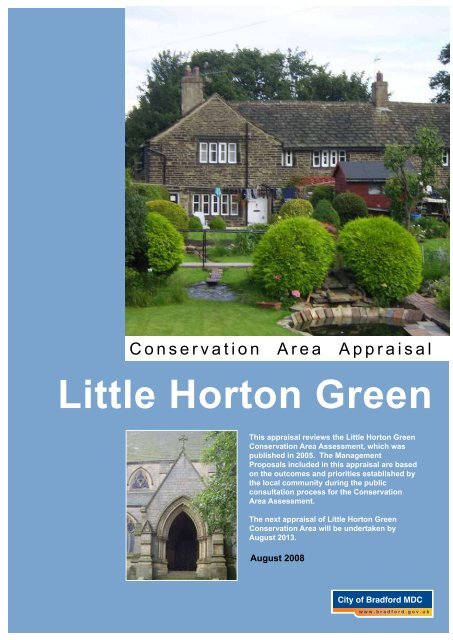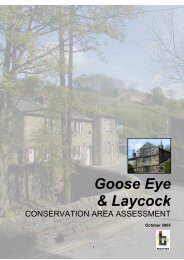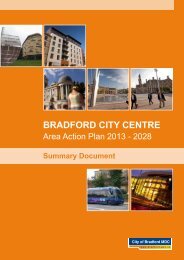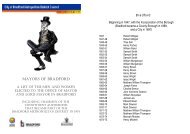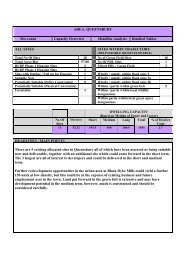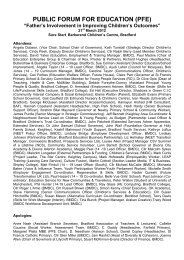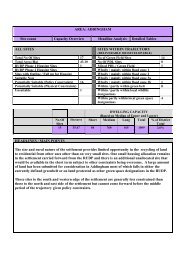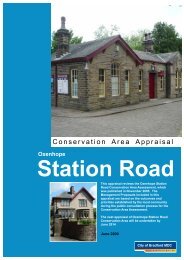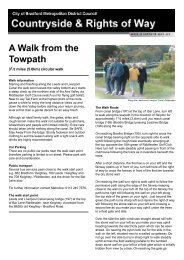Little Horton Green - Bradford Metropolitan District Council
Little Horton Green - Bradford Metropolitan District Council
Little Horton Green - Bradford Metropolitan District Council
You also want an ePaper? Increase the reach of your titles
YUMPU automatically turns print PDFs into web optimized ePapers that Google loves.
C o n s e r v a t i o n A r e a A p p r a i s a l<br />
<strong>Little</strong> <strong>Horton</strong> <strong>Green</strong><br />
This appraisal reviews the <strong>Little</strong> <strong>Horton</strong> <strong>Green</strong><br />
Conservation Area Assessment, which was<br />
published in 2005. The Management<br />
Proposals included in this appraisal are based<br />
on the outcomes and priorities established by<br />
the local community during the public<br />
consultation process for the Conservation<br />
Area Assessment.<br />
The next appraisal of <strong>Little</strong> <strong>Horton</strong> <strong>Green</strong><br />
Conservation Area will be undertaken by<br />
August 2013.<br />
August 2008<br />
City of <strong>Bradford</strong> MDC<br />
<strong>Little</strong> <strong>Horton</strong> <strong>Green</strong> Conservation Area Appraisal 1
What is a<br />
Conservation<br />
Area Appraisal<br />
What is a<br />
Conservation<br />
Area<br />
A Conservation Area Appraisal<br />
describes the character of<br />
a conservation area. It also<br />
describes the changes that have<br />
taken place in the conservation<br />
area over recent years.<br />
The appraisal finishes with<br />
management proposals which will<br />
help to conserve and enhance<br />
the area's special character and<br />
improve decision making<br />
in the future.<br />
The Government requires that all<br />
conservation areas have an up-todate<br />
conservation area appraisal.<br />
An up-to-date appraisal is one<br />
that has been undertaken within<br />
the past five years.<br />
The following work has been done to<br />
deliver this conservation area appraisal:<br />
• A photographic survey of the buildings<br />
in the conservation area.<br />
• The assessment of the level of<br />
authenticity of most of the historic<br />
buildings<br />
• An assessment of the issues facing<br />
the conservation area at present<br />
• The survey and update of map data<br />
relating to the conservation area<br />
• A review of the appropriateness of the<br />
conservation area boundary<br />
• An assessment as to whether new<br />
development has made a positive,<br />
negative or neutral impact on the<br />
character of the conservation area<br />
• The formulation of management<br />
proposals for the area<br />
A conservation area is an ‘area<br />
of special architectural or<br />
historic interest the character or<br />
appearance of which is desirable<br />
to preserve or enhance’ (Section<br />
69 of the Planning (Listed<br />
Buildings and Conservation<br />
Areas) Act 1990).<br />
<strong>Little</strong> <strong>Horton</strong> <strong>Green</strong> Conservation Area<br />
was originally designated in 1973. A<br />
review of the boundary of the<br />
Conservation Area was undertaken in<br />
2002-2003. The present boundary of<br />
the Conservation Area was adopted in<br />
September 2005.<br />
Conservation area designation brings<br />
with it extra controls. These controls<br />
cover:<br />
• demolition of unlisted buildings;<br />
• minor developments such as<br />
porches, extensions, satellite dishes<br />
and boundary walls; and<br />
• works to trees.<br />
The objective of these measures is to<br />
help preserve the special character and<br />
appearance of the area and maintain or<br />
improve its environmental quality.<br />
Whilst it is recognised that conservation<br />
areas must be allowed to evolve to meet<br />
changing demands it is important that<br />
this occurs within a framework of<br />
controlled and positive management.<br />
2 <strong>Little</strong> <strong>Horton</strong> <strong>Green</strong> Conservation Area Appraisal
Contents<br />
Background and Brief History .......3<br />
Background and<br />
Brief History<br />
Key Characteristics .......................4<br />
Strengths .......................................6<br />
Weaknesses ..................................6<br />
Opportunities .................................7<br />
Threats ..........................................7<br />
Conservation Area Maps ...............8<br />
Changes Affecting the<br />
Conservation Area ......................11<br />
Negative Impacts ........................13<br />
Management Proposals ..............14<br />
<strong>Little</strong> <strong>Horton</strong> <strong>Green</strong> Conservation Area covers a hamlet which has<br />
retained its rural and self contained character, despite being within a<br />
kilometre of City Hall. The following timeline briefly summarises its<br />
development.<br />
Contacts<br />
& Further<br />
Information<br />
Design and Conservation Team<br />
8th Floor, Jacobs Well,<br />
Manchester Road<br />
<strong>Bradford</strong> BD1 5RW<br />
Telephone:<br />
(01274) 433952<br />
Fax:<br />
(01274) 433767<br />
e-mail:<br />
conservation@bradford.gov.uk<br />
Webpages:<br />
Conservation homepage:<br />
www.bradford.gov.uk/conservation<br />
Conservation Area Assessments:<br />
www.bradford.gov.uk/<br />
conservationassessments<br />
Listed Buildings:<br />
www.bradford.gov.uk/listedbuildings<br />
12th century<br />
Although it was probably first settled<br />
in Saxon times and was probably<br />
one of the unnamed sub-manors of<br />
<strong>Bradford</strong> Manor in the Domesday<br />
Book of 1086, the first mention of<br />
<strong>Little</strong> <strong>Horton</strong> was in 1177 when<br />
<strong>Horton</strong> was subdivided into the<br />
constabularies of <strong>Little</strong> <strong>Horton</strong> and<br />
Great <strong>Horton</strong>. <strong>Little</strong> <strong>Horton</strong> <strong>Green</strong><br />
was the main settlement of <strong>Little</strong><br />
<strong>Horton</strong>, the smaller of the two areas<br />
created by the subdivision.<br />
17th century<br />
By this time the Sharp family, who<br />
had owned lands in <strong>Little</strong> <strong>Horton</strong><br />
since the 13th century, had become<br />
Lord of the Manor of <strong>Little</strong> <strong>Horton</strong>.<br />
The medieval <strong>Little</strong> <strong>Horton</strong> Old Hall<br />
was rebuilt in 1675, and the seat of<br />
the manor, <strong>Horton</strong> Hall, was rebuilt<br />
in 1677. Following suit, other old<br />
timber framed buildings were<br />
encased in stone, including <strong>Little</strong><br />
<strong>Horton</strong> Hall, 5-9 <strong>Little</strong> <strong>Horton</strong> <strong>Green</strong><br />
and 18-21 <strong>Little</strong> <strong>Horton</strong> <strong>Green</strong>.<br />
18th & early 19th<br />
centuries<br />
Older buildings were converted and<br />
subdivided into cottages and new<br />
folds and rows of cottages were<br />
built. These were the homes and<br />
workplaces of textile workers and<br />
include 49=54 <strong>Little</strong> <strong>Horton</strong> <strong>Green</strong><br />
and 46-52 Pullan Street.<br />
Mid 19th century<br />
Francis Sharp Powell inherited <strong>Little</strong><br />
<strong>Horton</strong> Manor (which included the<br />
hamlet itself) and resisted all offers<br />
to buy his land, which by now was<br />
becoming surrounded by <strong>Bradford</strong>.<br />
Sharp Powell completed his village<br />
with All Saints Church and All Saints<br />
School which were built in the<br />
1860s.<br />
Late 19th to 21st century<br />
The estate passes into the hands of<br />
the Powell Sharp Trust who manage<br />
the buildings and land owned by the<br />
Sharp Powells. The hamlet is very<br />
much as it was in the 19 th century<br />
and survives as a unique enclave of<br />
pre- and early industrial buildings in<br />
<strong>Bradford</strong>. Unfortunately both <strong>Horton</strong><br />
Hall and <strong>Horton</strong> Old Hall were<br />
demolished in the 1960s. Their site<br />
was later developed as <strong>Horton</strong> Hall<br />
Close.<br />
<strong>Little</strong> <strong>Horton</strong> <strong>Green</strong> Conservation Area Appraisal 3
Key<br />
Characteristics<br />
The following summarises the key elements of the<br />
character The following of <strong>Little</strong> <strong>Horton</strong> <strong>Green</strong> conservation area:<br />
summarises the<br />
• Vernacular style farm building<br />
and key cottages elements of<br />
• A strongly historic street pattern<br />
of<br />
the<br />
old lanes<br />
character<br />
and footpaths<br />
of<br />
• Buildings Keighley set back from Town the road<br />
at differing distances, reflecting<br />
the haphazard development Centre of<br />
the area<br />
• Strongly<br />
conservation<br />
rural character despite<br />
the area’s inner city location<br />
area:<br />
• Predominantly residential but<br />
there is a mix of building and land<br />
uses<br />
• Traditional natural building<br />
materials<br />
• Open spaces and greenery<br />
Group of terraced properties showing a traditional roofscape<br />
41 <strong>Little</strong> <strong>Horton</strong> <strong>Green</strong> has retained a full height chimney, traditional roof and windows<br />
4 <strong>Little</strong> <strong>Horton</strong> <strong>Green</strong> Conservation Area Appraisal
Top right: Full height traditional boundary<br />
walls.<br />
Top: The majority of fixed and sash windows<br />
have been retained.<br />
Middle: An example of good stone street<br />
surfaces.<br />
Above: Just one of the properties that has<br />
retained a large garden and the presence of<br />
trees.<br />
Summary of<br />
Important<br />
Features and<br />
Details<br />
Features and details contribute<br />
to the essential character of the<br />
conservation area:<br />
• Good examples of local<br />
vernacular architecture which<br />
varies according to the age and<br />
original status of buildings. The<br />
Victorian church and school,<br />
however, are Gothic revival in<br />
style.<br />
• Traditional stone elevations,<br />
traditional door and window<br />
details to buildings.<br />
• Traditional railings and walls<br />
demarcate boundaries<br />
• Stone street surfaces (where<br />
these remain in situ)<br />
• Lack of alteration / modern<br />
engineering to streets<br />
• Group value of terraces and folds<br />
of cottages and farm buildings<br />
• Footpaths providing alternative<br />
routes through the area.<br />
• Large gardens and the presence<br />
of trees and other greenery give<br />
a village rather than urban<br />
character<br />
Current Condition<br />
AUTHENTICITY 90%<br />
• Each historic building in a<br />
conservation area will have<br />
originally had features and<br />
details which contribute to the<br />
character of the conservation<br />
area.<br />
• The level of authenticity is<br />
based on an assessment of<br />
each building to ascertain the<br />
level of retention of original<br />
features.<br />
• Features assessed are:<br />
chimneys, roofs, rainwater<br />
goods, walls, windows and<br />
doors, boundary walls. Not all<br />
buildings will have all the above<br />
features and the scoring is<br />
adjusted to take this into<br />
account.<br />
• Only residential, commercial<br />
and civic buildings built prior to<br />
1956 are scored.<br />
• 54 properties were assessed<br />
for the purpose of the study;<br />
this is 69% of all properties<br />
within the conservation area.<br />
• The listed buildings had an<br />
average authenticity rating of<br />
90%.<br />
AUTHENTICITY<br />
90%<br />
<strong>Little</strong> <strong>Horton</strong> <strong>Green</strong> Conservation Area Appraisal 5
A breakdown of the authenticity assessment shows which<br />
features and details in particular are being retained and/or<br />
maintained and where there are the greatest threats.<br />
Strengths<br />
• The majority of the buildings<br />
retain almost all of their<br />
traditional features and details<br />
• Strongly traditional roofscape<br />
and unaltered traditional facades<br />
to most buildings.<br />
• Self contained character and<br />
strong sense of place<br />
• Rural character despite inner city<br />
location<br />
• Street pattern has changed very<br />
little<br />
• The successful re-use, and<br />
adaptation of some of the<br />
buildings<br />
• Significant areas of traditional<br />
streetscape materials are still in<br />
situ<br />
• The area’s listed buildings tend<br />
to retain a high proportion of their<br />
original features and details<br />
• The unlisted buildings are in<br />
general as well conserved as the<br />
listed buildings<br />
• Key open spaces maintain their<br />
traditional character<br />
• No vacant buildings.<br />
• Lack of modern engineering to<br />
some streets.<br />
• High quality views and vistas<br />
through and across the area.<br />
• <strong>Little</strong> <strong>Horton</strong> <strong>Green</strong> retains a<br />
higher proportion of traditional<br />
building details than almost all of<br />
the other conservation areas in<br />
the district surveyed so far.<br />
• Traditional boundary walls<br />
remain in situ and retain their<br />
character.<br />
• The spaces about buildings<br />
(particularly gardens) are well<br />
maintained and traditional in<br />
character.<br />
Weaknesses<br />
• Some of the footpaths through<br />
the area are unkempt and feel<br />
unsafe.<br />
• Some of the public spaces could<br />
make a stronger conribution<br />
The majority of traditional features and<br />
details have been retained<br />
Some traditional details<br />
have been lost from<br />
this property<br />
6 <strong>Little</strong> <strong>Horton</strong> <strong>Green</strong> Conservation Area Appraisal
Opportunities<br />
• Better decisions by all<br />
stakeholders (property owners,<br />
the Planning Service, Highways)<br />
through reference to the<br />
Conservation Area Assessment<br />
and this review and subsequent<br />
workshops and more<br />
communication with the Design<br />
and Conservation Team.<br />
• Recently published Repair and<br />
Maintenance Guidance<br />
should help property owners<br />
make better informed decisions.<br />
Threats<br />
• Loss of traditional features and<br />
details from buildings.<br />
• Poor decisions concerning<br />
planning applications,<br />
enforcement cases, listed<br />
buildings, highway<br />
management, and trees.<br />
• Loss of historic street surfaces<br />
and traditional character of<br />
public realm.<br />
• Buildings become vacant<br />
• Traditional character of open<br />
spaces lost<br />
Small scale alterations can commulitively undermine a<br />
property’s contribution to the street scene<br />
<strong>Little</strong> <strong>Horton</strong> <strong>Green</strong> Conservation Area Appraisal 7
<strong>Little</strong> <strong>Horton</strong> <strong>Green</strong> Conservation Area<br />
Character Contributions<br />
LIT TLE HORTON GREEN<br />
PULLAN STREET<br />
Key<br />
Conservation Area Boundary<br />
Areas providing a positive contribution to character<br />
Areas providing a negative contribution to character<br />
Areas providing a neutral contribution to character<br />
NB The ‘positive’, ‘negative’<br />
and ‘neutral’ areas relate<br />
to the contribution the<br />
site/building currently<br />
makes to the character of<br />
the Conservation Area. The<br />
classification in no way<br />
means that the site/building<br />
has no special architectural,<br />
historic or archaelogical<br />
interest.<br />
8 <strong>Little</strong> <strong>Horton</strong> <strong>Green</strong> Conservation Area Appraisal
<strong>Little</strong> <strong>Horton</strong> <strong>Green</strong> Conservation Area<br />
Open Spaces, Trees, Views, Listed and Key Unlisted Buildings<br />
LIT TLE HORTON GREEN<br />
PULLAN STREET<br />
Key<br />
Conservation Area Boundary<br />
Key open space<br />
Listed building<br />
Key unlisted building<br />
NB This map does not identify<br />
key trees individually, but<br />
merely indicates where there<br />
is at least one important tree.<br />
Important tree(s)<br />
Key view or vista<br />
<strong>Little</strong> <strong>Horton</strong> <strong>Green</strong> Conservation Area Appraisal 9
<strong>Little</strong> <strong>Horton</strong> <strong>Green</strong> Conservation Area<br />
Land Use and Highway Materials<br />
LIT TLE HORTON GREEN<br />
PULLAN STREET<br />
Key<br />
Conservation Area Boundary<br />
Other non residential building<br />
Residential<br />
Retail / Commercial building<br />
Place of worship / religous<br />
Educational building<br />
Gravel<br />
Stone setts / flags<br />
Un-surfaced / partially surfaced<br />
Tarmac / concrete<br />
10 <strong>Little</strong> <strong>Horton</strong> <strong>Green</strong> Conservation Area Appraisal
Any changes<br />
that have had a<br />
significant impact<br />
on the character<br />
or appearance of<br />
the conservation<br />
area since<br />
the previous<br />
assessment in<br />
2005 are detailed<br />
below.<br />
Changes<br />
affecting the<br />
Conservation<br />
Area<br />
New Development<br />
No significant new development has been identified as having taken place<br />
since 2005.<br />
Trees and Open<br />
Space<br />
No trees of amenity or townscape value have been lost in the conservation<br />
area since the publication of the conservation area assessment. The tree<br />
mentioned had been felled with consent.<br />
POSITIVE CHANGE<br />
Works to<br />
Highways<br />
There have been no significant<br />
works to the highways of the<br />
conservation area since 2005.<br />
NO CHANGE<br />
Buildings<br />
There were no vacant buildings in<br />
2005 and there are presently no<br />
vacant buildings.<br />
Boundary<br />
The boundary of the conservation<br />
area has been reviewed as part of<br />
this Appraisal and its is deemed<br />
to be appropriate.<br />
Key views into <strong>Little</strong> <strong>Horton</strong> <strong>Green</strong><br />
<strong>Little</strong> <strong>Horton</strong> <strong>Green</strong> Conservation Area Appraisal 11
Negative Impacts<br />
As part of the review of the conservation area a number of<br />
properties displaying inappropriate alterations and additions have<br />
been noted.<br />
Whilst a minority are considered<br />
to have a severely negative<br />
impact on the character of the<br />
conservation area, there are a<br />
number of properties displaying<br />
relatively minor visual detractors,<br />
such as inappropriate pointing<br />
and paintwork to stonework,<br />
inappropriate signage, poorly<br />
detailed shopfronts, and dormer<br />
windows. Other significant blights<br />
on the area are unused and<br />
underused buildings and sites.<br />
The <strong>Council</strong> will look to ways of<br />
mitigating these works and will<br />
actively discourage the occurrence<br />
of similar situations arising within<br />
the conservation area in the future.<br />
Design guidance on the repair and<br />
maintenance of historic properties<br />
has recently been made available<br />
and is available on the <strong>Council</strong>’s<br />
website at www.bradford.gov.uk/<br />
repairs.<br />
The loss of traditional detail in <strong>Little</strong> <strong>Horton</strong> <strong>Green</strong> can<br />
have a negative impact on the Conservation Area<br />
12 <strong>Little</strong> <strong>Horton</strong> <strong>Green</strong> Conservation Area Appraisal
Management Proposals<br />
The overall aim of the Conservation<br />
Area Management Proposals is to<br />
preserve and enhance the character<br />
of the Conservation Area, by<br />
ensuring that the <strong>Council</strong> and the<br />
community work together to maintain<br />
historic features and details and limit<br />
the loss of character.<br />
The objectives aim to:<br />
• Improve service delivery.<br />
• Raise awareness and understanding<br />
about the special character of the<br />
conservation area.<br />
• Improve decision making so that all<br />
repair, development and alteration<br />
result in a positive contribution to the<br />
character of the place.<br />
The objectives of the Management<br />
Proposals are based on the issues<br />
identified in the <strong>Little</strong> <strong>Horton</strong> <strong>Green</strong><br />
Conservation Area Assessment and<br />
prioritised by members of the community<br />
who took part in the <strong>Little</strong> <strong>Horton</strong> <strong>Green</strong><br />
Conservation Area Assessment public<br />
consultation.<br />
Objective Actions Timescale<br />
1 Design and Conservation Team to maintain<br />
contact with the local community<br />
• Yearly newsletter about conservation area issues<br />
• Design and Conservation website to be made as<br />
informative, user friendly and up-to-date as possible<br />
Yearly 2006-<br />
2011<br />
2006-2001<br />
Vacant property on (constant)<br />
Market Street<br />
2 Improved communication between <strong>Council</strong><br />
officers and key partners in the conservation<br />
area<br />
3 Improve the quality and amenity value of<br />
the public realm, open spaces and highway<br />
materials in <strong>Little</strong> <strong>Horton</strong> <strong>Green</strong><br />
4 Preserve and enhance features and details<br />
that contribute to the character of <strong>Little</strong> <strong>Horton</strong><br />
<strong>Green</strong><br />
• Formation of a conservation area forum<br />
• Workshops<br />
• Closer working relationship between Design and<br />
Conservation and other <strong>Council</strong> Departments<br />
• Production of design guidance for the enhancement of<br />
the public realm<br />
• Guidance for the repair and maintenance of<br />
historic buildings was published by the Design and<br />
Conservation Team in 2007.<br />
Half yearly<br />
2006-2011<br />
2006-2011<br />
5 Maintenance of footpaths and boundary walls • Closer working between the Design and Conservation<br />
Team, property owners, Highways, and the Rights of<br />
Way Team.<br />
6 Promote good quality new development • Production of guidance on appropriate sympathetic<br />
design to suit the character of the conservation area.<br />
• Production of design briefs where appropriate.<br />
2006-11<br />
2006-2011<br />
7 Monitor Planning Applications to<br />
add value to the historic environment<br />
8 Address illegal works to listed buildings and<br />
unauthorised development<br />
Design and Conservation Team to work more effectively<br />
within the wider planning service.<br />
Liaison between Design and Conservation Team and<br />
Planning Enforcement Team<br />
2006-2011<br />
(constant)<br />
2006-2011<br />
(constant)<br />
9 Retain important trees Liaison between Design and Conservation Team and<br />
Trees Team<br />
2006-2011<br />
(constant)<br />
10 Monitor Change loss/gain and feedback to<br />
local community and <strong>Council</strong> officers working<br />
in the conservation area.<br />
Design and Conservation Team to review <strong>Little</strong> <strong>Horton</strong><br />
<strong>Green</strong> Conservation Area every five years in line with Best<br />
value Indicators 219a.<br />
August 2013<br />
<strong>Little</strong> <strong>Horton</strong> <strong>Green</strong> Conservation Area Appraisal 13
14 <strong>Little</strong> <strong>Horton</strong> <strong>Green</strong> Conservation Area Appraisal


